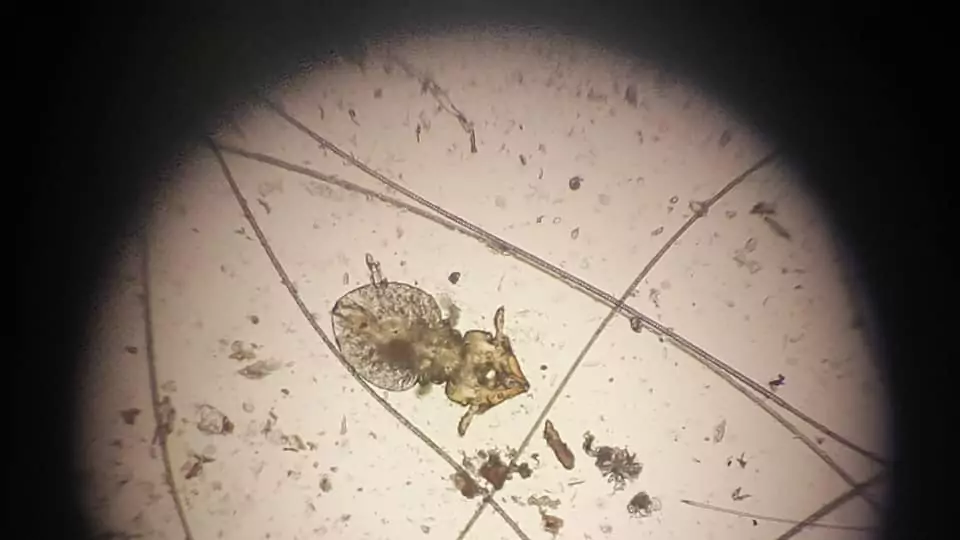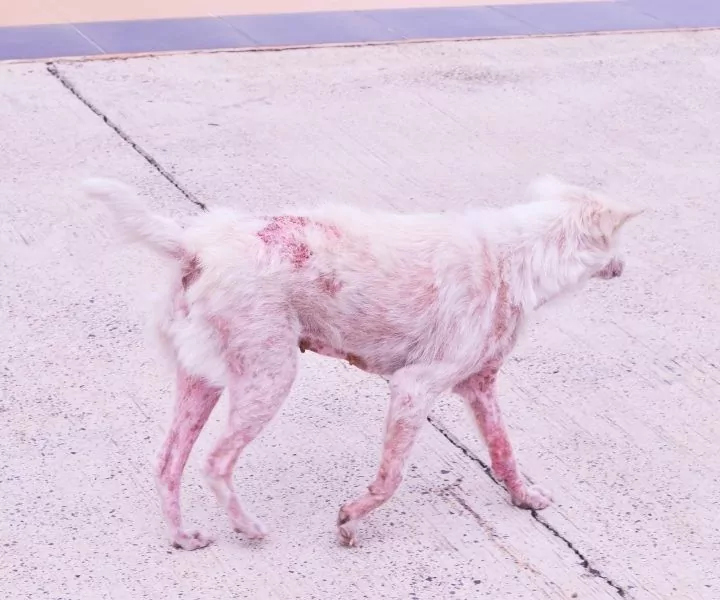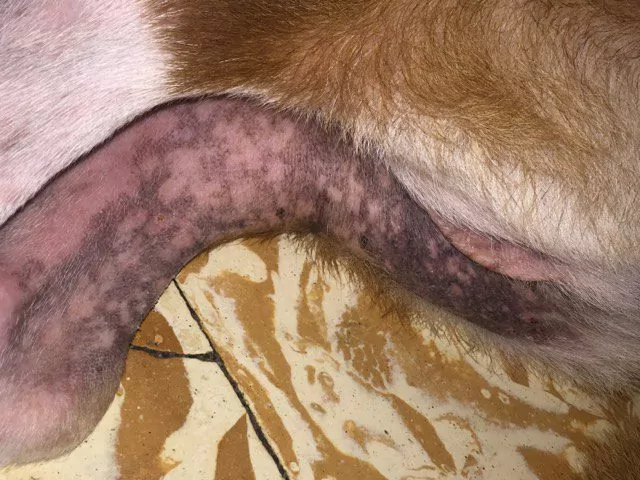What is Scabies in Dogs?
Have you heard about Scabies in dogs? Do you know that if your dog catches it, so can you? Yes, Scabies in dogs is also known as Sarcoptic mange! It is caused by a parasite called Sarcoptes scabiei, and can cause severe itching and fur loss in dogs. It is highly contagious and can even spread to other pets and humans.

Common Symptoms Associated With Scabies in Dogs
Scabies in dogs is a very contagious and relatively common disease.
The first thing most owners notice is their dog itching uncontrollably. This itching can start suddenly and be very intense. Intense itching (pruritus) is the most common symptom of Sarcoptes scabiei.
The sudden onset of intense itching is caused by a hypersensitivity to the mite and its feces. If this itching prolongs, it can lead to bruising and bleeding. These dogs can be very vocal while itching.
Other symptoms include:
Self-mutilation
Some dogs may scratch or bite the affected area causing significant damage to the skin
Fur loss
Fur loss (alopecia), inflammation, redness, and skin rashes soon follow. The most common areas are the belly, ears, elbows, and legs. But if left untreated, the entire body can be affected.

Bacterial infection
Additionally, dogs infected with scabies are susceptible to secondary bacterial or yeast skin infections. These can present in small bumps, thickened skin, crusty sores around the legs, ears, and abdomen.
Thickened skin
Thickening of the skin with crusts can be seen in advanced infestations of sarcoptic mange.
Odor
Dogs with long-term sarcoptic mange may develop a foul odor. This odor can transfer to any furniture and bedding.
Anorexia
Dogs with severe itching sometimes alter their feeding and sleeping patterns. Over time this can lead to weight loss and even death.
Typical Causes of Canine Scabies
Canine scabies (Sarcoptic mange) is a condition that affects dogs worldwide. It is caused by a mite Sarcoptes scabiei var. canis. It is primarily found in domestic dogs but can also be maintained in the wildlife population; coyotes, wolves, and foxes.
Although this parasite can survive in the environment for short periods, transmission is usually through direct contact with an infected animal. Areas that host high numbers of dogs, such as dog parks, daycares, grooming parlors, and boarding kennels, will give your dog a higher risk of contracting canine scabies than a walk in the woods.
It only takes a small number of mites to cause severe itching, and your dog may have picked up the infection from the furniture or bedding of an infected dog.
Sarcoptic mange is not primarily caused by poor hygiene. However, dogs who are not on routine heartworm and parasite preventatives are susceptible to infection. The macrocyclic lactones (ivermectin, selamectin) and milbemycins (moxidectin, milbemycin) used in these preventatives will also prevent mite infections.

Determining when or where your dog got infected can be difficult. The incubation period of canine scabies can be anywhere from as short as ten days to as much as eight weeks. The number of mites in the initial infection, the area infected, and your dog’s health play a significant factor.
Sarcoptes scabiei var. canis has a life cycle of 14 to 21 days spent entirely on the infected dog. The female of the parasite will burrow tunnels into the skin of the dog, where she would lay her eggs.
The eggs hatch within three days, and the immature stages gradually move out the tunnel onto the skin, mature, then make their own tunnels. There are five stages in the life cycle (egg, larvae, two nymphs, adult), and it only takes two to three weeks to get from egg to adult.
The adult mite can easily pass from one dog to another. So if one dog in a house or group is infested, the others will soon be infected as well.
Clinical Features of Scabies in Dogs
When should you go in to see your veterinarian?
If your dog suddenly starts itching uncontrollably without relief, you should take it to your veterinarian. Skin disease will vary from dog to dog, and there are many causes; however, sudden onset of intense itching is a characteristic sign of canine scabies.
It is important to tell your veterinarian that you suspect canine scabies before bringing your dog in. This will allow them to prepare an isolated area to examine your dog and take the necessary precautions. Sarcoptes scabiei var. canis prefers naked skin.
The initial infection is usually on areas of skin without fur. These would primarily be the belly, armpits, and inside the ears. The elbows and feet are sometimes affected early on.
Dogs can go as far as mutilating themselves to relieve the itch. These moderate cases can cause loss of appetite or even no interest in food altogether. Advanced infestations can lead to dogs becoming deaf or even blind.
In advanced infestations, the skin can develop pustules and crusting. Thickened skin with significant fur loss is also a symptom of progressive disease. If left untreated, scabies can infect your dog’s entire body.
Diagnosing Scabies in Dogs
Your veterinarian will start by taking a detailed history and doing a physical exam. Where your dog has been and what parasite preventatives it is on is just as crucial in determining a canine scabies infection as doing the diagnostic tests.
A procedure called a deep skin scrape will be the standard test to check for mite infection. The vet will scrape out layers of the dog’s skin to examine under a microscope. The aim will be to isolate the actual mite, which will give a definitive diagnosis.

Sarcoptes scabiei can have severe reactions with very low numbers, so most times, this skin scrape method may not have any visible mites in dogs that are infested. Yes, the test can be negative when the dog is infected.
Some veterinarians may also take blood samples from the dogs and ask you to bring in a fecal sample on your visit. These tests are less reliable than the skin scrape in diagnosing scabies but can be used to rule out other causes of itchy skin.
If the clinical signs and history fit canine scabies, most veterinarians will put the dog on treatment even if the diagnostic tests are all negative or inconclusive.
The Treatment of Scabies in Dogs
Treatment of Sarcoptic mange is usually manageable with medication if the infection is uncomplicated and detected early. It is important to note that all the dogs in your household should also be treated.
Clipping or grooming the dog will be necessary to improve the efficacy of topical treatment. Your dog would have to be soaked in medicated shampoos to remove the debris and crusting. An anti-mite dip should then be applied.
Lime-sulphur is a very safe and effective topical treatment for sarcoptic mange. The dog may need several dips with this product to eliminate the infestation. This is also safe to use in young dogs. Internal and or topical antiparasitic medicine is an effective alternative to washing and dipping.
Considering that some internal mange medication is also used for heartworm prevention, your veterinarian will test for heartworm disease before starting the dog on these medications. This is to avoid any possible complications of a heartworm-positive dog reacting to the treatment.
If your dog had secondary bacterial infections, this would be remedied by placing them on antibiotic therapy. Steroids and anti-inflammatory medication may also be necessary to reduce inflammation in advanced cases.
Although Sarcoptes scabiei does not survive well in the environment, the bedding and other material that the dog was in contact with should be washed with hot water or discarded. It is important to complete the treatment protocol set by your veterinarian. Dogs can quickly get re-infected with sarcoptic mange.
Affected humans may not need medical intervention since treating the dog usually eliminates the source of the human infection. Routine antiparasitic preventative medication is necessary to avoid reinfection.
Dogs with advanced sarcoptic mange may need long-term treatment. Immunocompromised dogs and dogs with underlying diseases will usually need treatment for that disease as well.
Prognosis and Recovery of Canine Scabies
Here is some good news!
Dogs infected with Sarcoptic mange usually make a full recovery when treated. They have an excellent prognosis! The disease is usually cleared in less than a month, but sometimes it can take six weeks or more. The secondary bacterial or yeast infections can generally be subdued with antimicrobial therapy.
Sarcoptic mange is highly contagious, and the mites can survive on contact surfaces for a few days. Although it is unnecessary to decontaminate your entire house, high contact areas should be thoroughly cleaned or discarded.
Which Types of Mange Are Dogs Susceptible to?
There are two types of mange that dogs can get. Sarcoptic mange (canine scabies) more common and highly contagious, and the lesser common Demodectic mange.
Unlike Sarcoptic mange (canine scabies), which is caused by Sarcoptes scabiei var. canis and can be transmitted via bedding, or even humans, Demodectic mange (red mange) is caused by Demodex canis and is usually only transmitted from mother to puppy.
Demodectic mange is a condition that does not present in normal healthy dogs. Even if the mite is present in the skin, a dog with a healthy immune system should control the numbers and avoid infestation. Some breeds like Pit Bulls and German Shepherds are more susceptible to Demodex infestations than other breeds.
Demodectic mange is not thought to be contagious, and transmission predominantly occurs from mother to pups in the nursing period. Sarcoptic mange is presented in one primary way, which can develop into advanced disease. But, Demodectic mange can present in three different forms.
Dogs with demodectic mange can have localized infection, generalized infection, or a condition called Demodectic pododermatitis.
Localised demodicosis
The dogs have small areas of fur loss in a specific place. This is usually seen in puppies with patches of fur missing from their head and face.
Generalized demodicosis
This will present multiple areas of fur loss all over the dog’s body. This mainly occurs in dogs under two years of age which are immunocompromised. As a result, they also develop secondary bacterial skin infections and a foul odor associated with the condition.
Demodectic pododermatitis
This is a condition seen in breeds like Old English sheepdogs and Shar peis. Bacterial infection almost always develops with this form of demodicosis. The infection is rooted deep in the dog’s feet, making it hard to diagnose and even harder to treat!
Remember that sarcoptic mange is highly contagious, and it can be transmitted through a variety of modes.
Pet owners will first notice the sudden onset of intense itching when their dog contracts canine scabies. Whereas, in a demodectic mange infestation, the owner will notice a gradual loss of fur. The onset of itching only follows secondary bacterial infections.
Similar diagnostic tests are done to determine which type of mange a dog may be infected with. A skin scrape and microscopic exam may prove diagnostic.
Demodex canis is usually present in the dog’s skin but in much higher numbers, and a routine skin scrape will usually isolate many. This mite has a characteristic cigar shape that is easily distinguishable.
Treatment of both types of mange is very similar, with the medical management varying based on the dog’s health and the presence of secondary infections.
When you hear about dog mites, you would probably hear about ear mites in dogs. This will cause itching of the ear and can sometimes be confused for canine scabies. Ear mites are small white mites that live in the ear canal.
Dogs infected with ear mites will scratch the ear and shake the head a lot. This can cause secondary complications such as bacterial and yeast ear infections or traumatic injury to the blood vessels causing what is known as an aural hematoma. It is essential that you take your dog to the veterinarian to diagnose and get treatment started early.
A microscopic exam also diagnoses the dog ear mite, but it is much easier for your veterinarian to isolate those. Sometimes ear mites can even be seen with the naked eye.
Monthly heartworm and ectoparasite (Flea & ticks) preventatives will also prevent mite infestations. But you will need to see your veterinarian before starting your dog on any of these!
Can Scabies in Dogs Transfer to Humans?
If you are asking yourself, can you get scabies from your dog? The simple answer is yes, you can! One in every ten pet owners with an infested dog gets infected by Canine scabies. However, Sarcoptes scabiei var. canis can only survive for a few days to a week on a human.
More importantly, your infection will clear up when you get your dog treated. Humans exposed to canine scabies may experience the same symptoms of itchiness and discomfort. But the condition is self-limiting since this variant cannot complete its life cycle on a human.
If you haven’t heard about scabies in humans, here is a bit of information about it. A different parasite causes the human disease equivalent of canine scabies. So yes, humans have their own type of scabies.
Scabies in humans is caused by a mite called Sarcoptes scabiei var. hominis. Although it is a close relative to the ectoparasite that causes scabies in dogs, the human variant only has four life stages (the canine variant has five life stages).
Sarcoptes scabiei var. hominis burrows into the infected human’s skin lay its eggs in the tunnels, then the larva matures, moving to the surface of the skin. This is very similar to the canine variant’s life cycle. Both are highly contagious and cause intense itching (severe pruritus), starting very suddenly with a relatively low infestation.
The human condition is called mange, the itch, itch mite, mite, seven-year itch, crusted scabies, and sometimes referred to as lice. However, there is no clinical relationship between lice and scabies. If you think you may be exposed to canine scabies or human scabies, you should see your doctor.
Even though a human with canine scabies will not get a full infestation, they can develop secondary bacterial infections in the skin and affected areas if left untreated.
Infants infected with human scabies usually have blisters and pimples on the palms of their hands and the soles of their feet. Sick, elderly, and immunocompromised people can get super infestations known as crusting scabies or Norwegian scabies.
This is the most complex form of scabies to treat. It is characterized by a scaly rash and thickened skin containing thousands of mites. It is comforting to know that unlike scabies in dogs, human scabies is only transmitted by human-to-human contact, and the mite cannot live more than three days away from a human host.
Treatment of Scabies in humans usually requires prescription medication. The mite is very hard to find in the average infection, so the tests are typically negative. Your doctor may still put you on the treatment plan if you have the clinical signs.

Emphasis is usually placed on the prevention of re-infection. Your doctor may ask to see your sexual partner and family members as well. Clothing, sheets, and towels used by the infected person are usually washed on high heat.
So if you and your dog or the other pets in the house have developed an episode of itching which came on suddenly but intensely and persistently, it’s time to book a trip to your doctors. You may have been exposed to Canine scabies.
There is an excellent prognosis with early detection and treatment. Then you can focus on preventing reinfection.
